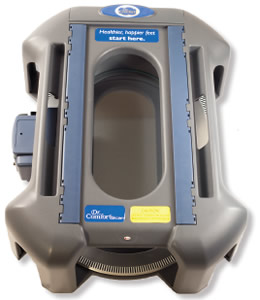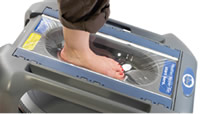Product Spotlight
Making an Accurate Map
Without an accurate “map” of a patient’s foot, a shoe or orthotic insert will not deliver the correct support, circulation and relief that a patient requiring special footwear needs. The Dr. Comfort Scan aims to take orthopedic footwear accuracy to the next level.
- By David Kopf
- Dec 05, 2013
 Accuracy is a pivotal element in good orthotics. Without an accurate “map” of a patient’s foot, a shoe or orthotic insert will not deliver the correct support, circulation and relief that a patient requiring special footwear needs. So, providers and manufacturers are constantly trying to perfect the ways in which they measure feet.
Accuracy is a pivotal element in good orthotics. Without an accurate “map” of a patient’s foot, a shoe or orthotic insert will not deliver the correct support, circulation and relief that a patient requiring special footwear needs. So, providers and manufacturers are constantly trying to perfect the ways in which they measure feet.
Orthopedic footwear maker Dr. Comfort’s recently unveiled Dr. Comfort Scan aims to bring a whole new level of accuracy to the foot-mapping process. The device combines a number of features, such as 3D mapping using lasers; a unique way for suspending patients’ feet while the mapping takes place; and wireless portability.
3D Scanning
Originally, orthotics and orthopedic footwear was made using foam impression boxes. A provider’s staff would help a patient carefully place his or her foot into a box filled with a special foam. The foam conforms to the patient’s foot, and that impression is used to make the custom footwear.
On the face of things, this seems like a good way to make a one-to-one impression of a patient’s foot, but it is subject to slight inaccuracies if there is any foot movement, and it entails other a couple other difficulties, as well:
First off, foam impression boxes are wasteful. If the patient moves and distorts the foam, there is no way to return it to its original shape. So a new box must be used. Not only does this cost money, but burning through boxes also isn’t exactly the nicest way to treat Mother Earth.
Second, once an accurate impression is taken, the provider needs to ship the box to its footwear manufacturer. This adds time and cost to the process. And, if the orthotic footwear manufacturer gets the impression and it has either been damaged in shipping, or wasn’t taken correctly, then the whole process needs to start over, consuming more time and adding to patient (and provider) frustration.
“Being a large lab, we get a lot of impression foam in, so we see a lot of waste, not just from materials, but with time,” says Mike Klug, insides sales supervisor for Dr. Comfort. “We’ve always wanted to find a way to reduce the number of things we throw away, which, as a large company with a large footprint, we always should be doing.
“But a big reason we wanted to do it is to make the patient experience better,” he continues. “When we looked at all the breakthroughs in technology that we’ve seen lately, the question became, ‘Why not try do something like this, that brings custom orthotics measurement into the 21st Century?’”
So 3D scanning makes a good deal of sense for eliminating a good bit of waste and cost, as well as possible inaccuracy from the foot-mapping process.
Like a lot of technology, 3D scanning is ever-evolving, with two main approaches: white light scanning and laser scanning. Unique to foot-mapping, the Dr. Comfort Scan uses a rotating laser to scan a patient’s foot, Klug explains.
Scanning the Foot

Patients step into the Dr. Comfort Scan device, which uses a rotating laser to create an accurate, three-dimensional map of the foot to create custom orthotics and footwear.
The process works likes this: The patient steps into an oval-shaped opening in the top of the Dr. Comfort Scan. Stretched across that hole is a patent-pending, transparent membrane that suspends the patient’s foot several inches off the ground. This way all of the unique curves of the foot’s surface are exposed without any sort of deformation, according to Klug. (The membrane is swapped out between patients.)
While the foot is suspended in space thanks to the membrane, a laser rotates around the foot below, running on an oval track that sits on the base of the Dr. Comfort Scan. This laser is constantly shooting tiny beams of laser light at the foot to collect 30,000 datapoints. These datapoints let the Dr. Comfort scan assemble a true 3D map of the patient’s foot.
Wireless Tablet Integration
Once the scan is taken, it appears on an accompanying wireless tablet that works with the Dr. Comfort Scan so that the practitioner can instantly see the scan of the foot and review it with the patient. And if something doesn’t look right, then another scan can be taken right then and there, Klug notes.
For portability, the Dr. Comfort Scan is charged overnight, and its batteries last long enough for all-day use. This means the device can easily be moved around a provider’s retail floor, just like any other foot measuring device, and could also be taken on the road, if the provider has staff visiting patients in the home.
The Dr. Comfort Scan is in final testing, and will be launched in early 2014. It will be available to Dr. Comfort providers at a cost that has not been set, but that will be minimal, especially in comparison to the box method, according to Klug.
“We’re hoping this replaces impression foam and measuring,” he says. “We’d really like this to be part of the Dr. Comfort experience. We’re hoping to keep the cost down to the point that every one of our providers sees this as a no-brainer.”
Dr. Comfort Scan
Dr. Comfort
(800) 556-5572
www.drcomfort.com
This article originally appeared in the December 2013 issue of HME Business.
About the Author
David Kopf is the Publisher HME Business, DME Pharmacy and Mobility Management magazines. He was Executive Editor of HME Business and DME Pharmacy from 2008 to 2023. Follow him on LinkedIn at linkedin.com/in/dkopf/ and on Twitter at @postacutenews.